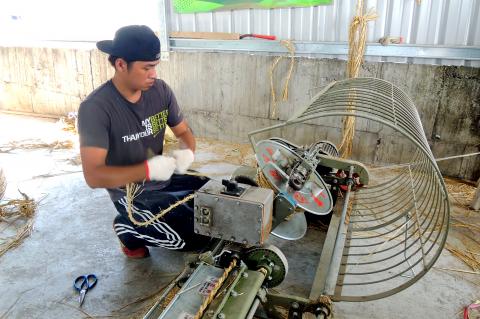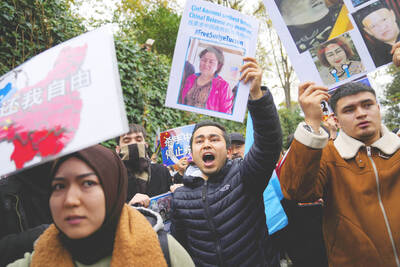It would be a shame to throw away all that rice straw after harvest, which is why the Kakawasang Cooperative purchases the straw from local farmers to make rope that is then sold to Japan. The cooperative has also developed cultural and creative products from the straw, building up a new eco-conscious industry in the area.
Cooperative president Sung Po-fang says that industries like woodworking and weaving are already quite developed among most Amis on the East Coast, and related markets have gradually become saturated. When local communities make woven products out of shell ginger leaves, they cut off the extra leaf parts on both sides to conform to a standard size. When people started using the leftover pieces to make shell ginger leaf hats, it inspired other ideas about how natural materials can be used.
When he went on the Internet looking for machines to process the leftover pieces of shell ginger leaves, Sung unexpectedly discovered machines for making straw rope that reminded him of the elders in his tribal village using rice straw to tie up sugarcane. Sung then began developing this nascent rice straw rope industry after applying for funding and personnel from the Ministry of Labor through its program for developing employment diversity.

Photo: Chang Tsun-wei, Liberty Times
照片:自由時報記者張存薇
In the areas surrounding Taitung City’s Fufong Community, where the co-op is based, there are around 700 hectares of rice fields, Sung says, adding that it is bad for the environment and wasteful for all the dry stalks from the paddy rice to be thrown out or burned after the harvest. Purchasing and collecting stalks from just one fen of land (969.92m2) can supply enough straw to make around 360 kilograms of straw rope, which is both eco-friendly and durable. The rope is highly popular in Japan. With help from a trading company, the Japanese market was successfully opened and around 20 tons of the rope has been exported, Sung says.
Project manager Tsai Chih-hao, 28, is currently in charge of making all the rope. Born in the Amis tribal village of Kararuan, Tsai decided to return home to take care of his aging parents after he completed his military service in February. It was an employment agency that introduced him to the culture and creative industry, which Tsai finds very interesting. He will try his best to learn everything and hopefully one day be able to create business opportunities in his hometown village, Tsai says.
The cooperative has also developed Japanese-style rice straw products that are used for prayer in Japan, turning rice straw, something once seen as garbage, into gold and creating a new local industry that has a lot of potential.
(Liberty Times, Translated by Kyle Jeffcoat)

Photo: Chang Tsun-wei, Liberty Times
照片:自由時報記者張存薇
收割後的稻草丟棄太可惜,東海岸原住民社區合作社向農民收購製成草繩,外銷到日本,還研發草繩文創商品,開創在地環保新興產業。
東海岸原住民社區合作社理事長宋博芳指出,東海岸阿美族大多發展木工、編織等文創產業,市場逐漸飽和,社區在製作月桃葉編織時,為了統一尺寸,會裁切掉兩旁多餘的葉面,大夥把這些「月桃鬚鬚」手工製成月桃帽,也引發利用自然素材的契機。
他說,上網搜尋希望找到可以加工月桃鬚鬚的機器時,意外發現編草繩的製繩機,想起以前部落老人家會拿稻桿搓繩綁甘蔗,因此向勞動部多元就業開發方案爭取經費及人力補助,開啟草繩產業。
東海岸原住民社區合作社基地位於台東市富豐社區,宋博芳說,周邊約有七百公頃水稻田,收成後稻桿只能丟棄或燒掉,不環保又浪費,以一分地兩百元收購整理,約可製成三百六十公斤的草繩,草繩環保又耐用,在日本頗受歡迎,透過貿易商協助,三月已成功打開日本市場,約外銷廿噸。
目前負責製作草繩的是專案經理人、廿八歲的蔡智豪,出身阿美族加路蘭部落的他二月退伍後,決定返鄉照顧年邁雙親,透過就業服務中心引介,順利投入有興趣的文創產業,他說,要儘量學習,未來也希望協助自己部落開發出更多商機。
東海岸原住民社區合作社另研發很有日本風味的祈福草繩等商品,將稻草從「垃圾變黃金」,也為在地開創很有發展潛力的新產業。
(自由時報記者張存薇)

Oxford University Press (OUP) will no longer publish a controversial academic journal sponsored by China’s Ministry of Justice after years of concerns that several papers in the publication did not meet ethical standards about DNA collection. A statement published on the Web site of Forensic Sciences Research (FSR) states that OUP will stop publishing the quarterly journal after this year. FSR is a journal that comes from China’s Academy of Forensic Science, an agency that sits under the Ministry of Justice. The academy describes FSR as “the only English quarterly journal in the field of forensic science in China that focuses on

A recent medical malpractice case involving a physician trained abroad has once again placed BoBo Doctors under public scrutiny. This incident has revived concerns about the quality of healthcare in Taiwan and highlighted ongoing debates regarding the legitimacy and impact of these doctors in the medical field. The term “BoBo Doctors” refers to Taiwanese students who fail to gain entry into domestic medical programs and instead pursue medical degrees in countries like Poland and other Eastern European nations. Not until they return to Taiwan do they attempt to qualify as practicing doctors by relying on their foreign qualifications to

A: A number of high-profile films are being released this summer movie season. B: I just went to see Superman and visited the Superman-themed DC pop-up store. A: F1, Jurassic World: Rebirth and The Fantastic Four: First Steps are also popular. B: Adapted from a fantasy novel, South Korean blockbuster Omniscient Reader Viewpoint — starring Lee Min-ho, Paul Ahn and Blackpink member Jisoo — is also highly anticipated. A: Let’s not forget that the Taiwanese film Gatao – Big Brothers, the newest of the Gatao series, is set to open next month. A: 今年暑期檔強片真不少! B: 我最近才剛看了《超人》,還去了超人主題「DC快閃店」。 A: 《F1》、《侏羅紀世界:重生》、《驚奇4超人:第一步》……等巨片也都大受歡迎。 B:

Continued from yesterday(延續自昨日) https://www.taipeitimes.com/News/lang According to supporters, a four-day workweek is an effective way for companies to attract and keep employees. Productivity can even be improved by achieving the same output in fewer hours. The primary workforce of the future, adults between the ages of 18 and 34, are strong supporters of this pattern. More than three-quarters of them believe a four-day workweek will become common practice in five years, while 65 person say they reject a return to full-time office work. This group considers mental health and general well-being as their top priorities, and it seems certain that they will be